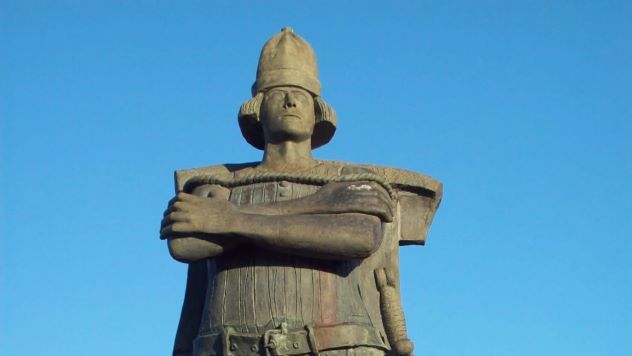10. What fate befell abigail?
The Salem witch trials stand out as a notorious episode in colonial American history, their details still cloaked in obscurity, particularly regarding the whereabouts of Abigail Williams. In 1689, Samuel Parris arrived in Salem, Massachusetts, assuming the role of a new minister. Accompanying him were his daughter Betty and her cousin Abigail. Initially, life proceeded normally. However, strange incidents began to afflict the girls in early 1692, manifesting as convulsions and speaking in tongues. This prompted the town doctor to diagnose them as bewitched. Tituba, a family slave, bore the brunt of blame, as the girls accused her of ensnaring them in witchcraft. Under duress, Tituba confessed and then implicated two more women.
The hysteria mounted as more girls exhibited similar symptoms, resulting in a cascade of witchcraft accusations against numerous individuals. Samuel Parris lost his position and departed with Betty, who resumed a conventional life. Meanwhile, Abigail Williams remained in Salem, playing a pivotal role in accusing an additional 57 people of witchcraft. However, after her testimony in June 1692, Abigail vanished from historical records, leaving behind no further trace. Contemporary experts speculate that her actions may have stemmed from her marginalized status in society, seeking fleeting control and influence. Alternatively, some suggest that Abigail and the other "afflicted girls" suffered from ergotism, a condition caused by consuming fungus-infected rye. Historians ponder whether this affliction might have led to her premature demise and subsequent erasure from historical narratives. Nevertheless, her ultimate fate remains a mystery, as the records offer no definitive conclusion to her disappearance.
9. Who's buried there?
In Japan, there exist ancient burial mounds known as kofun, constructed between the 3rd and 7th centuries AD. Unlike the renowned pyramids, these tombs feature a distinctive keyhole shape and come in various sizes, ranging from modest dimensions to expansive structures spanning thousands of feet. The largest among them, Daisen Kofun, situated in Sakai, Osaka Prefecture, boasts dimensions exceeding 1,500 feet (457 meters) in length and 1,000 feet (305 meters) in width. However, the identity of the individual interred within remains a mystery.
Traditionally linked with Emperor Nintoku, the 16th Emperor of Japan during the 4th century, no conclusive evidence from scholars or scientists supports this assertion. Access to the tomb has been strictly prohibited for decades, with archaeological investigations confined to the surrounding moats under the oversight of the Imperial Household Agency, responsible for Imperial Family affairs, since the 1970s.
Recent developments offer a glimmer of progress. In 2018, archaeologists gained permission to excavate the moats for ancient artifacts, and discussions about excavating the mound itself have surfaced since 2020, though such action has yet to materialize. Despite this, the prospect of uncovering the identity of the tomb's occupant appears more hopeful than ever, suggesting that this enduring mystery may finally yield answers in the years to come.
8. Who burned down the house?
During the Neolithic period in Europe, an intriguing trend emerged wherein individuals intentionally set fire to their own residences. Referred to as the "burned house horizon," this phenomenon was notably widespread within the Cucuteni-Trypillia culture of Eastern Europe, spanning regions of present-day Ukraine, Romania, and Moldova. However, the motivations behind this peculiar burning behavior remain cloaked in mystery.
Several theories attempt to elucidate this practice. The first two propose that the burnings were accidental, possibly caused by flammable materials or external attacks. However, these explanations fail to address the frequency of the burnings and the scarcity of human remains found within the charred structures.
Alternatively, other theories posit that the burnings were intentional but served different purposes. One hypothesis suggests that the houses were set ablaze to fortify their clay walls, rendering them more resistant to water. Another theory proposes that fires were used as a method of pest control, purging villages of insects and other pests.
Furthermore, the burnings may have functioned as a means of recycling old materials and creating space, or they could have been part of a religious ritual symbolizing the conclusion of a home's life cycle. Regardless of the explanation, the burned houses remain an enigmatic phenomenon that has piqued the interest of archaeologists and historians for centuries. Given the passage of time since these events occurred, it is likely that the true motivations behind these deliberate acts of destruction will remain forever elusive.
7. Where's the explorer?
Roald Amundsen, the renowned Norwegian explorer, etched his name in history with the groundbreaking 1911 expedition that reached the South Pole. However, his appetite for adventure persisted beyond this triumph. In 1926, he embarked on a perilous journey over the North Pole aboard a dirigible, alongside Italian aeronautical engineer Umberto Nobile and American financier Lincoln Ellsworth.
Following the flight, tensions between Amundsen and Nobile escalated, resulting in a highly publicized feud over expedition leadership. Despite their discord, news of Nobile's airship, the Italia, crashing during another Arctic exploration in 1928 prompted Amundsen to set aside their differences. On June 18, 1928, he and a French crew departed Tromsø, Norway, aboard a Latham 47 floatplane to aid in the rescue effort. Tragically, neither the crew nor the aircraft were ever seen again.
While it is widely believed that the plane crashed in the Barents Sea, the precise location and cause of the incident remain elusive, with no wreckage or bodies recovered despite intermittent search efforts and knowledge of the aircraft's route. In 2009, a team even utilized an underwater robot to explore 45 square miles (116.5 square kilometers) of the seafloor in pursuit of the plane's remains, but their endeavors proved fruitless. The enigma surrounding Roald Amundsen's final flight persists, enveloped in unanswered questions amidst the vast expanse of the unforgiving ice and sea.
6. Where'd the Brothers Go?

João Vaz Corte-Real, a renowned explorer of the 15th century, sailed under the banner of the Portuguese crown and held influential positions in the Azores Islands during his maritime career. His three sons—Gaspar, Miguel, and Vasco Añes—followed suit, seemingly destined for greatness in the annals of history. However, their journey took a tragic turn.
In 1500, Gaspar Corte-Real set out on a voyage to the North Atlantic, commissioned by King Manuel I of Portugal. Despite reaching Greenland, heavy ice prevented him from landing, prompting his return home. The following year, Gaspar led another expedition with three ships. Although he managed to navigate through the ice and reach new land, believed to be Newfoundland, historical records cast doubt on this claim. Upon arrival, Gaspar encountered indigenous peoples and, tragically, never returned to Portugal. The fate of his ship and crew remains lost at sea.
In 1502, Gaspar's brother Miguel organized a relief expedition with three vessels, aiming to search for Gaspar along the same shores where he had landed. Despite their agreement to regroup at a designated location, history repeated itself when Miguel's vessel failed to return.
Following these two devastating losses, the third brother attempted a rescue mission. However, the king, fearing further tragedy, dispatched additional ships but forbade the brother from joining. To this day, the fate of the Corte-Real brothers remains veiled in uncertainty. While historians speculate about shipwrecks, the specific details of their demise remain a mystery, perpetuating the tragic legacy of the Corte-Real family.
5. What (or who) killed Lin Biao?
In the realm of perplexing plane crashes, one incident stands out prominently: the Lin Biao incident. Lin Biao, a prominent general during the Chinese Communist Revolution, played a pivotal role in Mao Zedong's ascent to power. However, on September 13, 1971, tragedy struck under suspicious circumstances, claiming Lin Biao's life and that of his family in a plane crash over Mongolia. Yet, the crash's intricacies extend beyond initial impressions, and over 50 years later, the mystery endures.
Initially, the Chinese government remained tight-lipped regarding Lin's fate. It wasn't until a year following the crash that they disclosed the official narrative. Their assertion about Lin Biao's demise came as a shocker: he purportedly died while attempting to flee to the Soviet Union following a failed coup and an alleged assassination plot against Mao Zedong.
Predictably, this explanation failed to persuade many skeptics. The Soviet Union, concerned about the circumstances, dispatched its own agents to investigate the crash. However, their findings remained classified until the end of the Cold War. Eventually, in the 1990s, confirmation emerged that Lin Biao was indeed aboard the ill-fated flight, dispelling rumors of clandestine family executions or Mao's orchestration of secret imprisonment.
Despite this revelation, the precise circumstances surrounding the Lin Biao incident and his premature demise continue to elude historians and conspiracy theorists alike.
4. Who made the Footprints?
In the frosty evening of February 8, 1855, the inhabitants of Devon, England, awoke to find their surroundings draped in snow. Near the River Exe, the air was biting and the ground covered in a thick layer of snow. However, it wasn't just the wintry landscape that captured their attention. A more peculiar sight stirred up curiosity, concern, and fear—tracks resembling cloven hooves imprinted in the snow. No one could explain their origin, and there were no accompanying footprints to suggest a person or animal nearby. Immediately, many superstitious locals attributed the phenomenon to the work of the devil.
According to startling newspaper reports of the time, these tracks were attributed to a bipedal creature rather than a quadruped. Even more unsettling, the tracks appeared to defy conventional obstacles, passing through walls and continuing without interruption. They traversed haystacks, rooftops, and even crossed the river with apparent ease.
Skeptics attempted to offer rational explanations for the puzzling discovery. Suspected culprits ranged from escaped badgers to a kangaroo that had escaped from a private zoo. Another theory posited that mooring shackles from an experimental balloon launched from Davenport Dockyard may have left behind the hoof-like imprints. However, this explanation failed to account for the consistent spacing of the tracks. Was it all a fabrication? Perhaps a case of mass hysteria in overdrive? Regardless, the true explanation behind the "devil's footprints" of Devon remains a mystery to this day.
3. Who killed the Queen?
Anne Boleyn, the former Queen of England and consort of King Henry VIII, endured a tumultuous relationship with Thomas Cromwell, the king's chief minister and a pivotal figure in the English Reformation. Despite their initial alliance, their association soured over time, ultimately culminating in Anne's execution for treason. To this day, the question lingers: Did Cromwell engineer her downfall or merely execute the king's directives?
By 1536, Anne Boleyn had fallen out of favor with King Henry, chiefly due to her inability to produce a male heir and ideological disparities with Cromwell, despite their prior collaboration. Cromwell had previously played a crucial role in facilitating Henry's divorce from his first wife, thereby enabling his marriage to Anne and securing a position of influence.
However, in 1536, Cromwell amassed evidence implicating Anne in various adulterous affairs, including purportedly with her own brother. Found guilty, she met her demise on May 19, 1536, clearing the path for Henry VIII to marry Jane Seymour shortly thereafter.
While much of the evidence against Anne Boleyn was likely fabricated or extracted under duress, historians remain divided on Cromwell's role in its procurement. Did he manipulate the king and conspire against a political adversary, or was he faithfully executing Henry's wishes from the outset? Unraveling Cromwell's modus operandi could offer valuable insights into Henry VIII's consequential reign and shed light on Anne Boleyn's complex life and tragic demise.
2. Where's the Tomb?
Cleopatra undoubtedly ranks among the most legendary figures of antiquity, yet her ultimate place of repose remains a mystery. According to accounts from Roman historians, following their defeat in the Battle of Alexandria, both Cleopatra and her paramour Mark Antony chose to end their lives. Cleopatra's decision came later, driven by the grim prospect of Octavian's intention to parade her through Rome as a trophy of conquest. Although Octavian permitted the lovers to be interred together, uncertainty shrouds whether Antony underwent cremation rather than mummification, and the exact location of their burial remains a subject of contention.
Ancient sources offer scant clues on this matter, fueling a spirited debate among Egyptologists regarding Cleopatra's potential resting site. While Alexandria emerges as an apparent candidate, recent scholarly focus has shifted toward the ruins of Taposiris Magna, an ancient city boasting a majestic temple dedicated to Osiris.
Excavations at Taposiris Magna have yielded numerous tombs, including a handful of mummies, prompting speculation regarding the identity of one possibly belonging to Cleopatra. Notably, a particularly intriguing discovery involved a pair of mummies interred side by side, adorned lavishly with gold leaf—a symbol of high status in ancient Egypt. Although these individuals were not Cleopatra and Mark Antony, their prominence underscores the significance of Taposiris Magna during Cleopatra's era, rendering it a plausible contender for her final resting place.
Recent archaeological findings at the site have further fueled speculation, prompting researchers to ponder whether they have indeed stumbled upon the elusive burial ground of the famed ancient queen.
1. What Doomed the Minoans?
More than a century ago, archaeologists unearthed ancient remnants of the Minoan Civilization on the Greek islands dotting the Aegean Sea. These discoveries unveiled the Minoans as a remarkably advanced society, pioneering developments in Europe during their time. Their achievements encompassed an intricate writing system, exquisite artwork, and majestic palaces, with the innovation of plumbing dating back as early as 1800 BC. However, by the mid-15th century BC, the Minoans confronted a swift decline, ultimately culminating in the collapse of their entire civilization. This prompts the fundamental query: what catalyzed their downfall?
Initially, the prevalent hypothesis attributed their demise to a volcanic eruption on the island of Thera (now Santorini). However, subsequent research revealed that Minoan life persisted post-eruption. This led to the consideration of additional factors. Some suggest that the eruption triggered catastrophic tsunamis and climatic changes, resulting in prolonged periods of inclement weather and subsequent agricultural failures.
While the occurrence of the eruption remains undisputed, it may not solely account for the Minoan downfall. Alternative viewpoints propose that seismic activity, such as a major earthquake, precipitated the collapse of Minoan palaces. Alternatively, another hypothesis posits that the Minoans succumbed to invasions by mainland Greeks, specifically the Mycenaeans, attributing the demise to human actions.
Nevertheless, certainty remains elusive. Whether a singular cause or a confluence of factors led to the downfall of Europe's earliest extraordinary civilization remains uncertain. Given the antiquity of the era under scrutiny, full elucidation may forever evade our grasp.












0 Comments